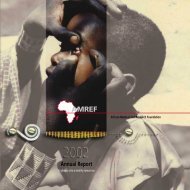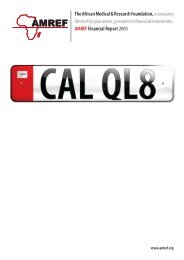Celebrating African Motherhood - Amref
Celebrating African Motherhood - Amref
Celebrating African Motherhood - Amref
Create successful ePaper yourself
Turn your PDF publications into a flip-book with our unique Google optimized e-Paper software.
UGANDA<br />
Home-based Care Management of Childhood Illnesses<br />
Northern Uganda is in the process of healing and reconstruction after two<br />
decades of civil war between Joseph Kony’s Lord’s Resistance Army rebel<br />
group and Government forces that violently disrupted life in the region.<br />
Hundreds of people were killed and maimed, and close to two million were<br />
displaced from their homes. About 40,000 children were abducted to serve<br />
as fi ghters, porters or sex slaves in the rebel army. The regional economy<br />
was destroyed and as the fi ghting intensifi ed, the Government moved<br />
people into protective camps, severely disrupting their social, economic<br />
and cultural lives. Basic essential services like education, health and water<br />
supply were thrown into disarray.<br />
AMREF has been working in Northern Uganda since 1998. Even during<br />
the war, AMREF worked in the volatile region, vaccinating children, and<br />
providing clean water and sanitation in the camps for internally displaced<br />
people in Gulu, Pader and Kitgum. In Gulu, AMREF opened a shelter where<br />
children could take refuge every night to escape abduction by rebels.<br />
With the end of hostilities, the people of Northern Uganda are struggling<br />
to rebuild their lives. However, they are doing this within a context of<br />
poverty and tattered social infrastructure, including a very fragile health<br />
system. Strengthening of the health care system is crucial to improving<br />
the living conditions of the population and achieving sustainable postconfl<br />
ict development. AMREF’s work in Northern Uganda is driven by the<br />
vision of a health care system that operates eff ectively, interacting with<br />
local administrative structures and the communities themselves, which is<br />
therefore responsive to the needs of the people.<br />
Of major concern is the high rate of illness and death among children. In<br />
Gulu for example 250 out of every 1,000 children under fi ve die every year,<br />
mostly as a result of malaria, respiratory and intestinal infections.<br />
Since 2006, AMREF has been addressing children’s health in Pader and<br />
Kitgum districts through its Home-based Management of Childhood<br />
Illnesses project. By training Village Health Teams, including community<br />
vaccinators and community medicine distributors, AMREF ensures that<br />
the major health needs of the communities are met. In particular, AMREF<br />
supports local capacity to provide home-based services for preventing<br />
and treating malaria, the leading cause of child deaths in Uganda, and<br />
for vaccination of children. Through training of health workers, provision<br />
of equipment, including motorcycles to facilitate movement to distant<br />
villages, and strengthening of referral systems, the programme ensures<br />
that health centres in the region are better able to perform their preventive,<br />
diagnostic and treatment functions, especially with regard to malaria.<br />
So far, AMREF has trained 1,570 VHT members, 1,002 men and 568 women.<br />
The project has resulted in a drastic drop in the number of malaria cases in<br />
the two districts. This is because children are treated for malaria within the<br />
crucial fi rst 24 hours of the onset of fever. Malaria in pregnant women has<br />
fallen too, improving chances of survival for the mothers and their babies.<br />
FACTS AND FIGURES<br />
• 28,912 children were treated for malaria by Village Health<br />
Teams in 2009<br />
• 80 per cent of children under fi ve in the project area receive<br />
antimalarial medicine within the fi rst 24 hours of the onset<br />
of fever, compared with 63 per cent before the project<br />
• AMREF has dug over 100 boreholes in Gulu, Pader and<br />
Kitgum Districts. Each borehole is used by about 170<br />
people.<br />
DONORS<br />
• Compagnia San Paolo<br />
• Fondazione Carparma<br />
• Fondazione Cariplo<br />
• Monte dei Paschi di Siena<br />
39





